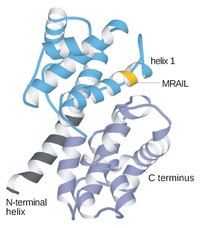
Photo from wikipedia
BACKGROUND Sex-determining region Y-box (SOX) proteins function as transcriptional regulators. The derivation of melanocytes from nerve crest cells has been reported to depend on SOX proteins, including SOX10 and SOX5.… Click to show full abstract
BACKGROUND Sex-determining region Y-box (SOX) proteins function as transcriptional regulators. The derivation of melanocytes from nerve crest cells has been reported to depend on SOX proteins, including SOX10 and SOX5. Whether SOX6 is expressed and has a functional role in melanocytes is unknown. OBJECTIVE We aimed to study the effect of transcription factor SOX6 on melanogenesis in alpaca melanocytes. METHODS We verified the role of SOX6 in melanogenesis by overexpressing and inhibiting SOX6 in melanocytes. Co-immunoprecipitation (co-IP) experiments were performed to further explore the function of SOX6 in melanogenesis and its mechanism of melanin production. We found that SOX6 interacted with cyclin-dependent kinase (CDK5), β-catenin, and Cyclin D1. RESULTS Bioinformatics analysis suggested that SOX6 has a phosphorylation site for CDK5, which regulates melanogenesis, suggesting that SOX6 might play a role in melanogenesis. Co-IP experiments indicated that SOX6 interacted with CDK5, β-catenin, and Cyclin D1. Quantitative real-time polymerase chain reaction and western blot analyses of SOX6-overexpressing melanocytes revealed increased mRNA and protein expression of Cyclin D1, CDK5, microphthalmia transcription factor (MITF), tyrosinase (TYR), tyrosine related protein-1 (TYRP1), and dopachrome-tautomerase (DCT), whereas β-catenin levels decreased in SOX6-overexpressing melanocytes. The opposite results were observed upon SOX6 knockdown. The melanin content was significantly increased or decreased, respectively, by SOX6 overexpression or knockdown. CONCLUSION Our results suggest that SOX6 might enhance melanogenesis by binding with β-catenin to increase Cyclin D1 and MITF expression.
Journal Title: Journal of dermatological science
Year Published: 2018
Link to full text (if available)
Share on Social Media: Sign Up to like & get
recommendations!